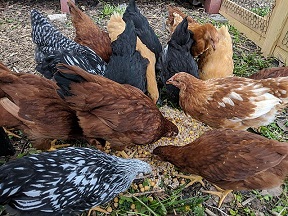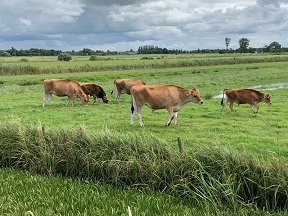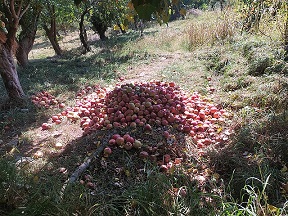Knowable Magazine ran an interesting article by Bob Holmes on meat consumption. Would we stop climate change if we stopped eating meat? Yes, we might – but then, from an environmental point of view there is no need to stop eating meat altogether. Although we should start raising livestock in a better way.

Climate change
Governments are slow to rise to the challenge posed by climate change. Should we take action as individuals? By eating less meat? After all, livestock contributes to about 14.5 percent of global greenhouse gas emissions – more than all the world’s cars and trucks combined. And meat consumption is on the increase. But some land is only fit for growing grass – eaten by cattle, not by humans. So what is the verdict, on balance?
On balance, it is clear that we should eat less meat. Animals are inefficient transformers of vegetal feedstock into meat. Feeding chickens, we lose about 50% of the vegetal input; for pigs this is about 75% and for cattle it is 70 to 90%. Moreover, the ‘weight gain’ includes bones, skin and guts. And, Knowable Magazine writes, ‘about 40 percent of the world’s arable land is now used to grow animal feed, with all the attendant environmental costs related to factors such as deforestation, water use, fertilizer runoff, pesticides and fossil fuel use.’ But we should add: much of this land is too steep, too wet, or marginal – not suitable for growing crops.

Side streams
Even if we grow crops, this will leave side streams that we cannot eat – whereas livestock can. Like the bran and germ left over when we mill wheat to white flour; or soy meal left over when we press the beans for oil. And there are fallen fruit, food leftovers and even insects, which most people won’t eat. So after all, livestock does fulfil a function in the global food system. Moreover, meat provides us with nutrients like iron and vitamin B12 that are hard to obtain from a purely vegetal diet.
On balance, therefore, we should allow some meat in our diets. Though in lesser quantities than the average person in wealthy countries eats nowadays. Consequently, a sustainable livestock system would be smaller, and probably different, than the present system. Which again raises the question: how much smaller? How much meat will leave this on our plates?
Less meat consumption
It would leave quite a substantial amount, research suggests. Vaclav Smil of the University of Manitoba estimated that we should cut back our meat consumption by just one third. Even if this a bit low, it is clear that mankind doesn’t have to refrain from eating meat altogether. But we need to take into account several factors. Hannah van Zanten of Wageningen University and Research in the Netherlands points out that the volume of leftovers may vary. A human diet with whole grains for instance will leave less for animals than a diet on refined grains. Also, we need to take into account that in such a world, the number of pigs and chickens will primarily be determined by the volume of leftovers; whereas cattle can graze on pasture – that can exist on land not fit for agriculture.

Eating less meat would require social and economic changes. Van Zanten notes that we will need systems for collecting household wastes, sterilizing them and processing them for feed. Some Asian countries are on this track already; Europe isn’t. Moreover, many animals are now fed on grains – we will have to abandon this system, a major transition. One of the consequences being that we will need much less cropland, about a quarter less. On which we could regrow forests.
Greenhouse gas emissions
There is another factor, often overlooked: greenhouse gas emissions. Grazing animals release methane gas from their stomachs. As a greenhouse gas, this is some 80 times stronger than carbon dioxide. What to do about this? Some researchers try to breed varieties that emit less methane gas. Add enzymes to the fodder that block methane production in the stomach. Move cattle more frequently, so that they eat more young grass and produce less methane. But the problem is that cattle feeding on grass will produce more methane than cattle fed on grain. But this may still suggest a solution to this problem. Van Zanten and colleagues calculated that livestock raised on leftovers and marginal lands will produce up to 31 percent less greenhouse gas emissions than livestock fed in the traditional way.
But will this be enough? Some climate experts argue that we should do more. They fear that we are on the track towards a climate tipping point – from which there would be no road back to the old situation. If we should keep livestock levels constant, then methane concentration wouldn’t rise any more. But wouldn’t it be too late for such a strategy already? Matthew Hayek and colleagues at New York University argue that we should embrace a plant-based diet by 2050. We need ‘aggressive, experimental, bold policies,’ Hayek argues, ‘not ones that try to marginally reduce meat consumption by 20 or even 50 percent.’
What to do?
So what’s the verdict, ‘on balance’? First of all, we should raise awareness of the issue. We humans need at most a moderate intake of meat. We generally don’t hear that from our governments yet. We could all become flexitarians. Meat alternatives are on the rise, both in quality and in quantity. From the viewpoint of quality, there is no need any more to be modest. We actually need a full-fledged public awareness campaign. Not driven by the moral point of view: thou shalt not eat meat. But assisted by top chefs who succeed in convincing the sceptics by creating top dishes. Served in top restaurants. Partly on the basis of vegetal ingredients, with the product resembling real meat or real fish. You doubt if we can do that? Then just remember that fifty years ago, smoking was quite common.
Then, we should regulate the livestock’s food intake; and reduce international food transports just for feeding animals. Curb food imports. Promote and perfect the use of leftovers, particularly for chickens and pigs. Downsize livestock levels to those determined by the availability of sustainable food. In sum, not an easy task – but this regulation of meat consumption may constitute a road towards a sustainable human diet.
Interesting? Then also read:
New protein sources will fill the gap
Meat is fine! No problem for world food supply, says Rudy Rabbinge
Perspectives for agriculture – the new farming
